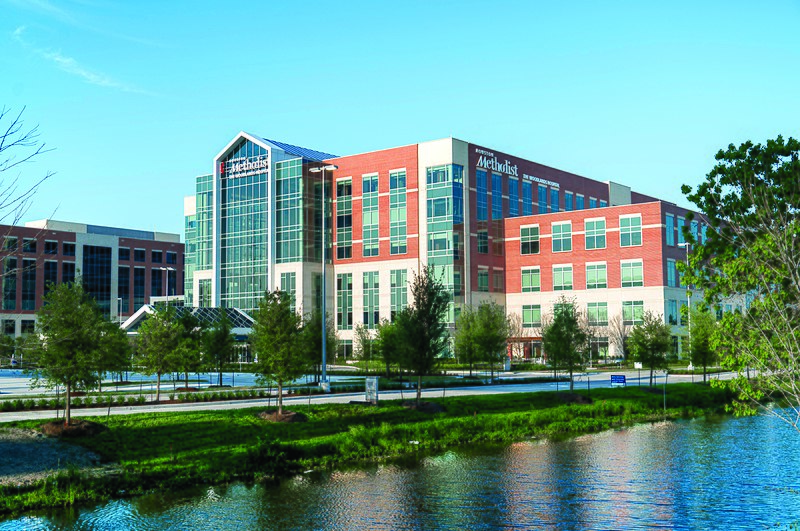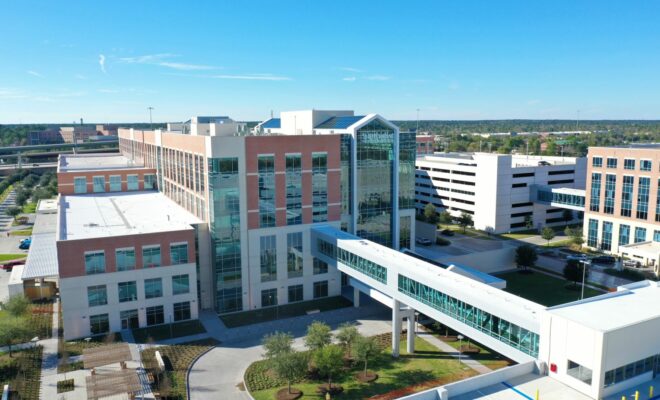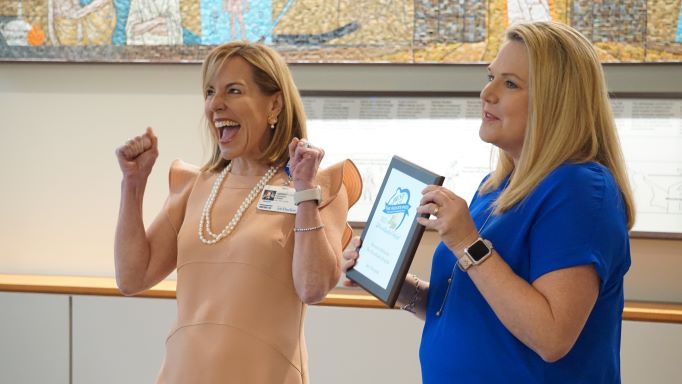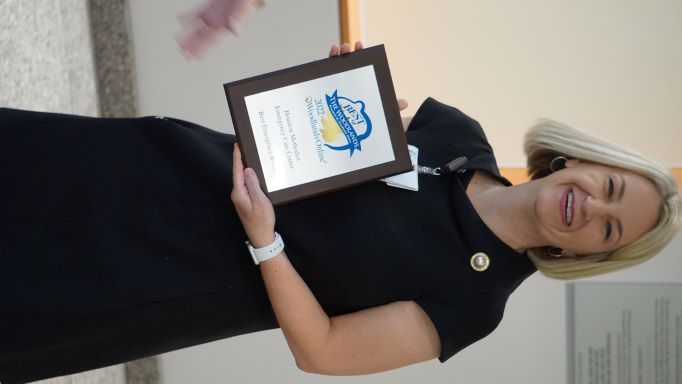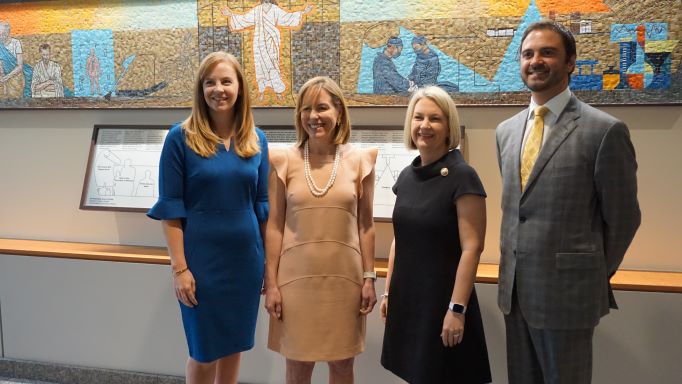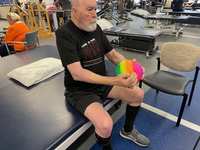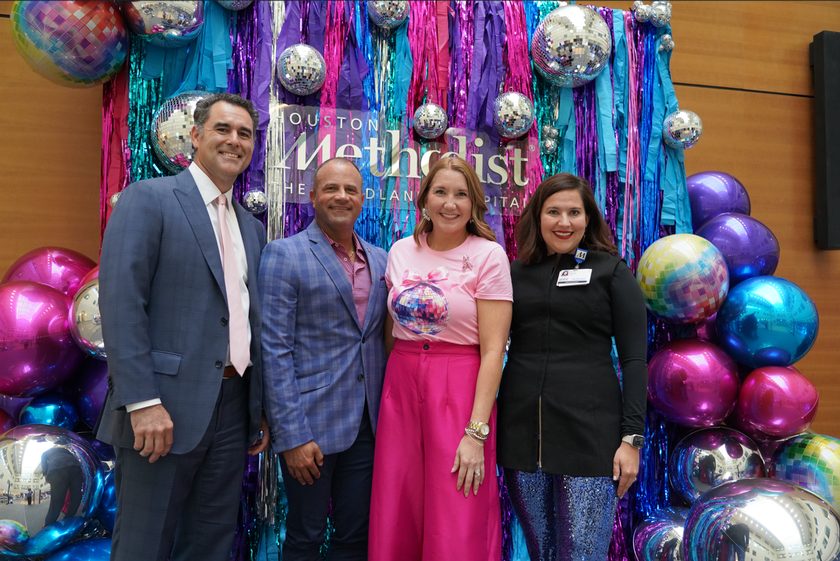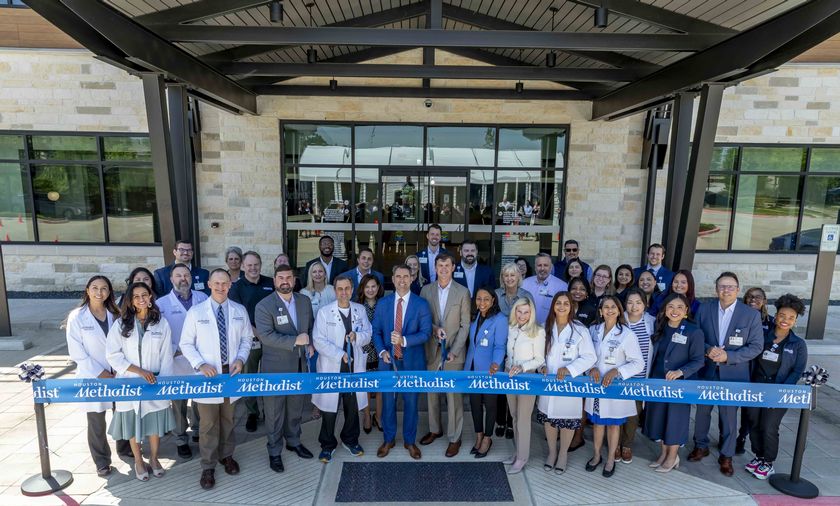- Sections :
- Crime & Public Safety
- Restaurants & Food
- Sports
- More
Categories
Houston Methodist Hospital – The Woodlands unveils a Healing Tower that reaches for the sky
THE WOODLANDS, TX – Healthcare in The Woodlands area took a bold leap upward with the recent opening of Houston Methodist Hospital's latest addition to the facility’s campus on Interstate 45 and FM 242. The hospital’s Healing Tower was unveiled to media and the public, a six-floor expansion that provides increased access to the latest and greatest in medical technology and services.
Arriving at a cost of approximately $250 million, Healing Tower represents the future of providing healthcare and treatments to patients. Every aspect of the facility is integrated with the latest in technology for improved diagnosis, treatment, and recovery. An expanded emergency department provides increased access to high-quality emergency care, and the operating rooms look like something out of Star Trek.
Woodlands Online was granted a full guided tour of the tower; however, before the tour began, WOL staff had their own treat for the hospital as our staff brought plaques commemorating Houston Methodist – The Woodlands’ first-place wins in the recent “Best of The Woodlands” competition.
The lobby of the tower is easily accessible from the newly constructed second parking garage through a covered walkway (and skyway granting access to upper levels). A warm, inviting reception area is designed to put visitors at ease from their moment of arrival.
The second floor contains the innovative pre-admission testing area, designed to provide incoming surgical patients with extra comfort and security, as evidenced by its private lobby and secured back areas. This area is the location to handle the pre-needs for upcoming surgery, including administering a COVID test to the patient, input of insurance information, financial and payment discussions, the signing of consent forms, and more. This way, on the day of the surgery, there is a much smaller time impact on patient and hospital alike.
Going through the controlled-access doors into the surgical/operating room center unveils a bustling area more than 100 yards long. The first thing to notice is a specialty scale that can weigh a person even if he or she is on a stretcher or in a wheelchair. A series of pre-op rooms soon follow, including an EKG room, lab, COVID test room, and consultation room. The proper medications and other pre-surgical necessities are administered here.
“We have an app called ‘Care Everywhere’ that facilitates our ability to look at a patient’s entire medical history and get questions answered in one easy step, even conversing with the patient while they are at home,” said Kathy Denny, RN, who guided much of the tour. “The pandemic impelled us to leverage technology in this entire tower.”
In addition to nine additional operating rooms (bringing the hospital’s OR count to 24), there is a robotics room that rivals anything that a science-fiction movie could display. With the in-room XI robot, intensely complicated procedures are possible, which was key in making Houston Methodist a winner for the “Center for Excellence in Robotic Surgery.”
As part of the next-generation design of the tower, each of the operating theatres are specialty pods known as “hybrid ORs” that best utilize the space. Equipment and monitors can be moved about – or even brought in or removed – with ease, and numerous large-screen monitors line the walls and heavy machinery to allow for multiple uses with their customizable screens.
According to Dr. Thomas Loh of the hospital’s vascular and endovascular surgery department, “Everything you see here is literally the latest and greatest in medical technology.” The robotics aspect allows for much greater survival and recovery rates, particularly amongst those who had formerly often-fatal conditions such as pulmonary embolisms. The success rate is so great that Methodist Houston works with Montgomery County Emergency Medical Services personnel to ensure that PE patients are brought to this facility.
Halfway along the long corridor that makes up the surgical wing is the Control Desk, a high-tech version of the typical nurse’s station. Again, multiple large monitors adorn the walls, allowing for easy and instant access to information on any and all patients. Another aspect of the technology in use is the personnel’s “touch-and-talk” badges that act much like a Star Trek communicator.
As well as two ORs that are specially designed for cardiovascular surgeries, the second floor of the tower is rounded off by the joint replacement and surgery operating room, run by orthopedic surgeon Eric Price, MD. Like the other rooms, technology accentuates the personal care in the form of a ROSA robot system that uses systems that are comparable to Xbox Kinect systems and the motion-control processes used in multimillion-dollar movies. As a result of this technological assistance, 50 percent of joint patients go home the same day.
The fourth floor of the tower is reserved for the Women’s Health Center, a one-stop shop for childbirth and related issues. Rooms are uniquely designed for ease of access with strollers. Four lactation stations with everything needed to facilitate the production of milk. Safety and protection is paramount; patients and qualified visitors are issued wristbands that are necessary for access and egress, and everyone has to stop at the front desk area or else risk setting off an automatic alarm.
The center features a 34-bed postpartum unit. Advanced technology is used to ensure proper medication administration to the correct patients; in these rooms, the armbands are scanned by the nurses and other personnel to ensure correct distribution of meds. They also feature latest-generation bassinets that have substantial safety features. Each room has the ability to allow both parents to stay overnight.
The treatment procedure room allows for neonatal procedures to be safely and conveniently performed. It’s a private area that allows the baby to stay in the unit and close to the parents. Two on-call rooms are fully staffed 24/7 to handle any emergencies in a rapid fashion. The ward is classified as a Level 3 maternity designation as well as a Level 3 NICU (neonatal intensive care unit) designation. The NICU is camera-accessed and extra-guarded. It includes a family lounge for families to have an open space to gather, eat, rest, and provide support to one another. Cutting-edge devices sanitize hands and cell phones alike for extra security.
The 24-bed NICU ward’s parenting room is a fully equipped hotel room for surrogate families and visitors. The room is also utilized for parents coming out of NICU who aren’t comfortable to go home quite yet. There are also “twin rooms” for parents who have just experienced multiple births.
“We are very family-centered care here,” said Denny. “Throughout time we’ve all learned – especially in the NICU environment – that having both parents is a setup for success. Research even indicates that family-centric care promotes better breastfeeding, helps with the bonding process, and dramatically lessens stress.” Part of this specialized family-oriented plan includes having 24/7 visitation access, special areas for siblings, and a visitor support system.
Director of acute care services, Nathan Way, MSN, RN, presented a guided tour of the sixth and latest of the hospital’s acute and intermediate care floors, situated on the fifth floor of the Healing Tower.
“One of the things that is unique about this department is that we built a very open central space, and we did this because care teams consisting of nurses, doctors, nutritionists, pharmacists, and more have to work together,” he said. “There’s literally a table in the middle for all of them to get together and be involved.”
Part of the layout that indicates the extra consideration that went into the construction of this tower is the steady series of alcoves built into the hallways to ensure that essential equipment is always close at hand without creating clutter or logjams.
“One of the things we like to talk about when we say ‘hospital of the future’ and ‘rooms of the future’ is a huge digital board that tracks each individual patient’s progress in real time, to let us know how they’re doing based on multiple data inputs,” said Way. “We partnered with a company called Responder 5 that provides a special call-bell system that gives us real time data monitoring, so that we can respond and adapt accordingly to patients who activate their call systems.”
The intermediate care unit consists of sixteen beds, and the adjoining telemetry medical-surgical unit consists of 16 patient care rooms. The IMU rooms are fully monitored with portable monitor units that can come with patients should they need to be moved. Innocuous at first glance, the bedside tables are a point of pride with Way, as they are specially connected for room residents to be able to charge their devices in a centralized location. Additionally, the rooms are each equipped with an iPad so that patients can stay connected with loved ones who can’t make it to the hospital. The iPads are designed to wipe histories and personalized settings – including the patients’ ‘My Chart’ readouts – upon discharge so that no sensitive information is released.
To alleviate the chance of bedsores, many beds have special circulatory systems that keep air moving underneath each patient; something so innovative that a recent family member of a patient was so impressed that he contacted the company and bought one for his home.
The presence of technology is apparent to any visitor, from controlled access to real time monitoring to devices called Care Agility Tools that are loaded with apps that entertain. connect, and educate. Front-line staff was trained to be proficient with these devices, and there is also a patient liaison team that is purely committed to room setup and device management and showing the less tech-savvy patients and family members how to operate them. The already-established Innovation Department was “kicked into overdrive” with the onset of COVID to ensure the technology and its devices and resources were ready to handle the additional load.
The sixth and top floor of the Healing Tower consists of 32 patient care rooms in an additional specialized telemetry medical-surgical unit, fully staffed and loaded with the latest technology like the ward beneath it.
A gigantic and beautiful art installation piece called ‘Galaxy’ was commissioned to be a central fixture of the tower’s open central area on the tower’s bottom two floors. Daniel Goldstein, a San Francisco-based artist, created the artwork that consists of more than 900 pieces of metal and measures out at 56 feet long by 21 feet wide.
“We chose to hang this beautiful piece in the open area because many people who wait in a hospital look up in thought or prayer, and here when they do they see this thing of beauty,” said Debra Sukin, regional senior vice president of Houston Methodist and CEO of Houston Methodist The Woodlands Hospital. “It provides a sense of hope to visitors and staff alike.”
Outside the tower proper, a second parking garage was constructed with each access to the tower at both ground level and via a skybridge. The garage adds an additional 800 parking spaces, another tangible piece of evidence of the hospital’s goal to alleviate as much stress of its visitors as possible.
A cafeteria, dining area, Starbucks, and convenience store are also easily accessible in an area filled with customized furniture and layouts. The convenience store is fully automated after hours for staff using their badges to access and purchase, ensuring the best possible experience for the tower’s providers.
“It’s essential to us that patients, visitors, caregivers, partners, and personnel alike are given the best possible care on every level from the moment they come through our doors to the time they leave and beyond,” said Sukin.
State-of-the-art equipment, specially trained staff, and an holistic approach sets a new standard in modern healthcare
Arriving at a cost of approximately $250 million, Healing Tower represents the future of providing healthcare and treatments to patients. Every aspect of the facility is integrated with the latest in technology for improved diagnosis, treatment, and recovery. An expanded emergency department provides increased access to high-quality emergency care, and the operating rooms look like something out of Star Trek.
Woodlands Online was granted a full guided tour of the tower; however, before the tour began, WOL staff had their own treat for the hospital as our staff brought plaques commemorating Houston Methodist – The Woodlands’ first-place wins in the recent “Best of The Woodlands” competition.
The lobby of the tower is easily accessible from the newly constructed second parking garage through a covered walkway (and skyway granting access to upper levels). A warm, inviting reception area is designed to put visitors at ease from their moment of arrival.
The second floor contains the innovative pre-admission testing area, designed to provide incoming surgical patients with extra comfort and security, as evidenced by its private lobby and secured back areas. This area is the location to handle the pre-needs for upcoming surgery, including administering a COVID test to the patient, input of insurance information, financial and payment discussions, the signing of consent forms, and more. This way, on the day of the surgery, there is a much smaller time impact on patient and hospital alike.
Going through the controlled-access doors into the surgical/operating room center unveils a bustling area more than 100 yards long. The first thing to notice is a specialty scale that can weigh a person even if he or she is on a stretcher or in a wheelchair. A series of pre-op rooms soon follow, including an EKG room, lab, COVID test room, and consultation room. The proper medications and other pre-surgical necessities are administered here.
“We have an app called ‘Care Everywhere’ that facilitates our ability to look at a patient’s entire medical history and get questions answered in one easy step, even conversing with the patient while they are at home,” said Kathy Denny, RN, who guided much of the tour. “The pandemic impelled us to leverage technology in this entire tower.”
In addition to nine additional operating rooms (bringing the hospital’s OR count to 24), there is a robotics room that rivals anything that a science-fiction movie could display. With the in-room XI robot, intensely complicated procedures are possible, which was key in making Houston Methodist a winner for the “Center for Excellence in Robotic Surgery.”
As part of the next-generation design of the tower, each of the operating theatres are specialty pods known as “hybrid ORs” that best utilize the space. Equipment and monitors can be moved about – or even brought in or removed – with ease, and numerous large-screen monitors line the walls and heavy machinery to allow for multiple uses with their customizable screens.
According to Dr. Thomas Loh of the hospital’s vascular and endovascular surgery department, “Everything you see here is literally the latest and greatest in medical technology.” The robotics aspect allows for much greater survival and recovery rates, particularly amongst those who had formerly often-fatal conditions such as pulmonary embolisms. The success rate is so great that Methodist Houston works with Montgomery County Emergency Medical Services personnel to ensure that PE patients are brought to this facility.
Halfway along the long corridor that makes up the surgical wing is the Control Desk, a high-tech version of the typical nurse’s station. Again, multiple large monitors adorn the walls, allowing for easy and instant access to information on any and all patients. Another aspect of the technology in use is the personnel’s “touch-and-talk” badges that act much like a Star Trek communicator.
As well as two ORs that are specially designed for cardiovascular surgeries, the second floor of the tower is rounded off by the joint replacement and surgery operating room, run by orthopedic surgeon Eric Price, MD. Like the other rooms, technology accentuates the personal care in the form of a ROSA robot system that uses systems that are comparable to Xbox Kinect systems and the motion-control processes used in multimillion-dollar movies. As a result of this technological assistance, 50 percent of joint patients go home the same day.
The fourth floor of the tower is reserved for the Women’s Health Center, a one-stop shop for childbirth and related issues. Rooms are uniquely designed for ease of access with strollers. Four lactation stations with everything needed to facilitate the production of milk. Safety and protection is paramount; patients and qualified visitors are issued wristbands that are necessary for access and egress, and everyone has to stop at the front desk area or else risk setting off an automatic alarm.
The center features a 34-bed postpartum unit. Advanced technology is used to ensure proper medication administration to the correct patients; in these rooms, the armbands are scanned by the nurses and other personnel to ensure correct distribution of meds. They also feature latest-generation bassinets that have substantial safety features. Each room has the ability to allow both parents to stay overnight.
The treatment procedure room allows for neonatal procedures to be safely and conveniently performed. It’s a private area that allows the baby to stay in the unit and close to the parents. Two on-call rooms are fully staffed 24/7 to handle any emergencies in a rapid fashion. The ward is classified as a Level 3 maternity designation as well as a Level 3 NICU (neonatal intensive care unit) designation. The NICU is camera-accessed and extra-guarded. It includes a family lounge for families to have an open space to gather, eat, rest, and provide support to one another. Cutting-edge devices sanitize hands and cell phones alike for extra security.
The 24-bed NICU ward’s parenting room is a fully equipped hotel room for surrogate families and visitors. The room is also utilized for parents coming out of NICU who aren’t comfortable to go home quite yet. There are also “twin rooms” for parents who have just experienced multiple births.
“We are very family-centered care here,” said Denny. “Throughout time we’ve all learned – especially in the NICU environment – that having both parents is a setup for success. Research even indicates that family-centric care promotes better breastfeeding, helps with the bonding process, and dramatically lessens stress.” Part of this specialized family-oriented plan includes having 24/7 visitation access, special areas for siblings, and a visitor support system.
Director of acute care services, Nathan Way, MSN, RN, presented a guided tour of the sixth and latest of the hospital’s acute and intermediate care floors, situated on the fifth floor of the Healing Tower.
“One of the things that is unique about this department is that we built a very open central space, and we did this because care teams consisting of nurses, doctors, nutritionists, pharmacists, and more have to work together,” he said. “There’s literally a table in the middle for all of them to get together and be involved.”
Part of the layout that indicates the extra consideration that went into the construction of this tower is the steady series of alcoves built into the hallways to ensure that essential equipment is always close at hand without creating clutter or logjams.
“One of the things we like to talk about when we say ‘hospital of the future’ and ‘rooms of the future’ is a huge digital board that tracks each individual patient’s progress in real time, to let us know how they’re doing based on multiple data inputs,” said Way. “We partnered with a company called Responder 5 that provides a special call-bell system that gives us real time data monitoring, so that we can respond and adapt accordingly to patients who activate their call systems.”
The intermediate care unit consists of sixteen beds, and the adjoining telemetry medical-surgical unit consists of 16 patient care rooms. The IMU rooms are fully monitored with portable monitor units that can come with patients should they need to be moved. Innocuous at first glance, the bedside tables are a point of pride with Way, as they are specially connected for room residents to be able to charge their devices in a centralized location. Additionally, the rooms are each equipped with an iPad so that patients can stay connected with loved ones who can’t make it to the hospital. The iPads are designed to wipe histories and personalized settings – including the patients’ ‘My Chart’ readouts – upon discharge so that no sensitive information is released.
To alleviate the chance of bedsores, many beds have special circulatory systems that keep air moving underneath each patient; something so innovative that a recent family member of a patient was so impressed that he contacted the company and bought one for his home.
The presence of technology is apparent to any visitor, from controlled access to real time monitoring to devices called Care Agility Tools that are loaded with apps that entertain. connect, and educate. Front-line staff was trained to be proficient with these devices, and there is also a patient liaison team that is purely committed to room setup and device management and showing the less tech-savvy patients and family members how to operate them. The already-established Innovation Department was “kicked into overdrive” with the onset of COVID to ensure the technology and its devices and resources were ready to handle the additional load.
The sixth and top floor of the Healing Tower consists of 32 patient care rooms in an additional specialized telemetry medical-surgical unit, fully staffed and loaded with the latest technology like the ward beneath it.
A gigantic and beautiful art installation piece called ‘Galaxy’ was commissioned to be a central fixture of the tower’s open central area on the tower’s bottom two floors. Daniel Goldstein, a San Francisco-based artist, created the artwork that consists of more than 900 pieces of metal and measures out at 56 feet long by 21 feet wide.
“We chose to hang this beautiful piece in the open area because many people who wait in a hospital look up in thought or prayer, and here when they do they see this thing of beauty,” said Debra Sukin, regional senior vice president of Houston Methodist and CEO of Houston Methodist The Woodlands Hospital. “It provides a sense of hope to visitors and staff alike.”
Outside the tower proper, a second parking garage was constructed with each access to the tower at both ground level and via a skybridge. The garage adds an additional 800 parking spaces, another tangible piece of evidence of the hospital’s goal to alleviate as much stress of its visitors as possible.
A cafeteria, dining area, Starbucks, and convenience store are also easily accessible in an area filled with customized furniture and layouts. The convenience store is fully automated after hours for staff using their badges to access and purchase, ensuring the best possible experience for the tower’s providers.
“It’s essential to us that patients, visitors, caregivers, partners, and personnel alike are given the best possible care on every level from the moment they come through our doors to the time they leave and beyond,” said Sukin.
Comments •

